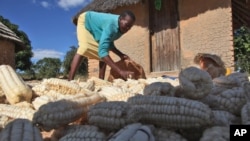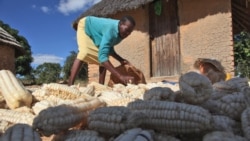Around the world, some 870 million people go to bed hungry most nights, according to the United Nations Food and Agriculture Organization, or FAO. The vast majority of them live in developing countries.
The United States supports the United Nations Millennium Development Goals to halve global poverty by 2015. To achieve this goal, food security and nutrition need to improve.
At the G-8 Summit in L’Aquila, Italy, four years ago, President Barack Obama called on global leaders to strengthen poverty, hunger and under-nutrition reduction efforts. He pledged $3.5 billion in new development assistance for food security and nutrition.
Feed the Future, born out of this commitment, is the U.S. government’s global hunger and food security initiative. Through Feed the Future, the United States supports partner countries to develop food security strategies, focusing on smallholder farmers and promoting private sector. Feed the Future supports smallholder farmer capacity development, increasing access to better farming techniques and agriculture inputs like seeds; improving access to processing facilities; and improving transportation infrastructure. Feed the Future also supports technology access to connect farmers to information, such as weather or crop disease warnings.
Led by the U.S. Agency for International Development, Feed the Future draws on 10 total US federal agencies to contribute to global food security work
The Department of Agriculture, or USDA, is a key partner in this effort.
In September, USDA announced that in fiscal year 2013, some 10.5 million people around the world will benefit from its food and nutrition programs. One program, the McGovern–Dole International Food for Education and Child Nutrition Program, supports education, child development and food security in low-income, food-deficit countries.
For example, a McGovern-Dole project operating in rural elementary schools in the poorest municipalities in Guatemala helped 70,000 children attend school and helped feed the families of 22,500 fourth to sixth graders. The project provides take-home food, scholarships, daily snacks, school gardens, PTA support, and donations of supplies to improve the learning environment.
“In addition to providing much-needed nutritious food, USDA’s food assistance programs also foster economic growth in the recipient countries,” said U.S. Secretary of Agriculture Tom Vilsack.
“The United States is committed to achieving global food security and supporting sustainable agricultural production.”
The United States supports the United Nations Millennium Development Goals to halve global poverty by 2015. To achieve this goal, food security and nutrition need to improve.
“The United States is committed to achieving global food security and supporting sustainable agricultural production.”U.S. Secretary of Agriculture Tom Vilsack
Feed the Future, born out of this commitment, is the U.S. government’s global hunger and food security initiative. Through Feed the Future, the United States supports partner countries to develop food security strategies, focusing on smallholder farmers and promoting private sector. Feed the Future supports smallholder farmer capacity development, increasing access to better farming techniques and agriculture inputs like seeds; improving access to processing facilities; and improving transportation infrastructure. Feed the Future also supports technology access to connect farmers to information, such as weather or crop disease warnings.
Led by the U.S. Agency for International Development, Feed the Future draws on 10 total US federal agencies to contribute to global food security work
The Department of Agriculture, or USDA, is a key partner in this effort.
In September, USDA announced that in fiscal year 2013, some 10.5 million people around the world will benefit from its food and nutrition programs. One program, the McGovern–Dole International Food for Education and Child Nutrition Program, supports education, child development and food security in low-income, food-deficit countries.
For example, a McGovern-Dole project operating in rural elementary schools in the poorest municipalities in Guatemala helped 70,000 children attend school and helped feed the families of 22,500 fourth to sixth graders. The project provides take-home food, scholarships, daily snacks, school gardens, PTA support, and donations of supplies to improve the learning environment.
“In addition to providing much-needed nutritious food, USDA’s food assistance programs also foster economic growth in the recipient countries,” said U.S. Secretary of Agriculture Tom Vilsack.
“The United States is committed to achieving global food security and supporting sustainable agricultural production.”


















